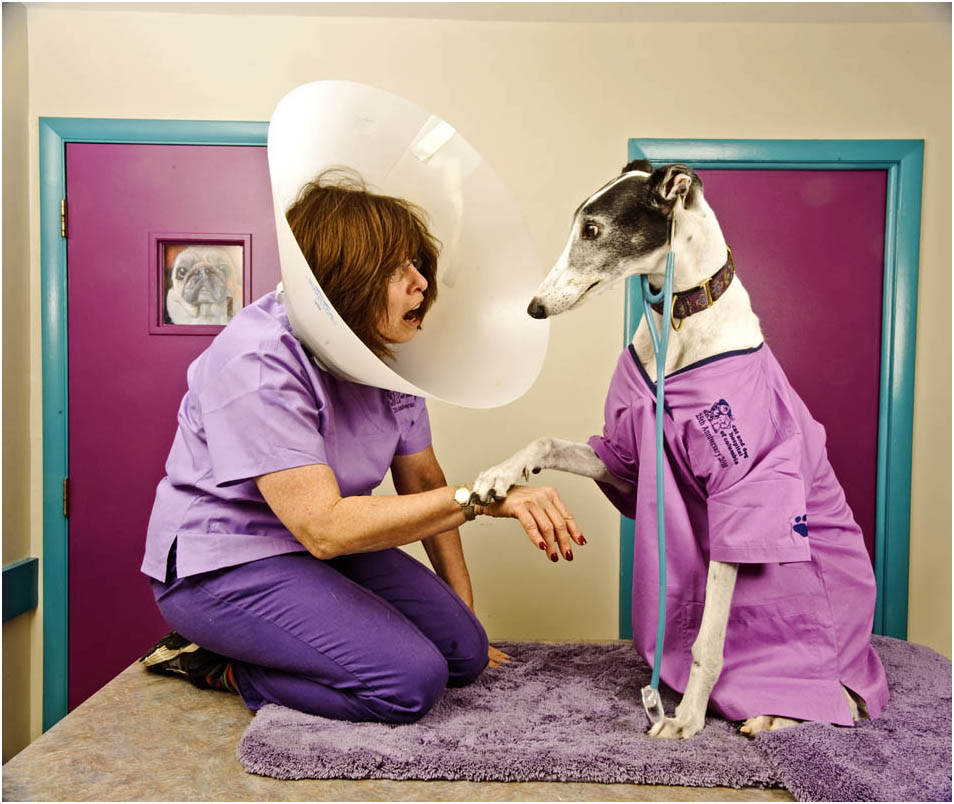
TID:
Thanks for taking part in this and sharing your thoughts.
Please tell us a little about the backstory of the image.
MATT:
Ross! Or should I call you TID? Thanks a ton for letting me be part
of this super-cool blog. I'm humbled and stoked!
Back when I used to be a staffer for the Patuxent Publishing Co.,
one of our products I would shoot for was Howard Magazine. It's
one of those hyper-local, glossy, lifestyle mags targeted for women
from 35-60. We got a new art director, Michele Moy. It went from
something stodgy and predictable, to a fun, visually engaging magazine.
Our Cadillac issue was the annual Best of Howard edition. The awards
are poll-based, so whoever has the most friends wins. It had nothing
intrinsically to do with quality. That being said, corporations like The
Cheesecake Factory would win "Best Dessert." But being a true hyper-
local publication, we would only feature the local winners.
Before the winners were picked, the magazine team, Creative Director
Michele Moy, Designer Brian Young, one other photographer (Drew
Anthony Smith in 2009, and Sarah Nix-Pastrana in 2010), and I would
brainstorm. We looked through the categories and picked which ones we
thought might be the most interesting to illustrate. I picked the ones I
wanted to shoot, and Drew and Sarah picked the ones they wanted. And
for most of the shoots we also had four pairs of hands to drag gear in,
set up, troubleshoot and break stuff down. These shoots gave me a taste
of how much I LOVE working with a crew.
We had room for 6 images -- 5 full page/double trucks and one cover.
BIG BEAUTIFUL PLAY!
Ever since Michele started, she's been really good about reinventing the
magazine. She was also blessed with a boss who was expertly hands-off.
That is to say, she knew what was going on, but knew not to meddle in
things she's not trained for (i.e. photography and design). So Michele was
given the keys to the car, so to speak. She also knew to trust us
photographers and be ready for surprises -- which is good for me.
I don't have the temperament to really WANT to sit down and plan
something out. As a result I'm pretty good at being, uh, for lack of a
better phrase, creatively resourceful on shoots. All that means is, I'm really
good at "making something out of nothing."
Truth be told, I get a little anxious when stuff is over-planned -
especially when it comes from someone else's brain. In my experience,
when expectations for a shoot are too tightly prescribed I tend to make
lackluster images.
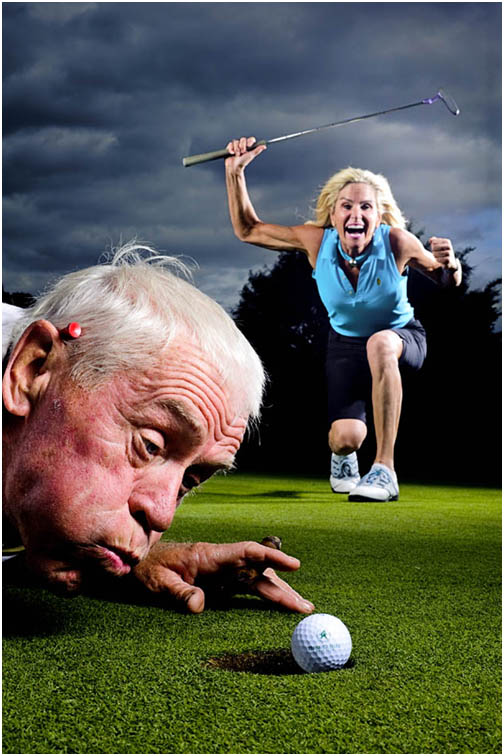
There are some exceptions, though. The Best Golf Course of Howard
County illustration was VERY planned out. We went on an extensive
tour of the golf course to find the right tee. There were a lot of logistics
to worry about. For example, what if someone needed to play through?
We also thought up the story beforehand: Warren Klauschus is trying to
blow Martie Browning's ball from going into the hole. We needed genuine
characters, visual storytelling layers, a clean background and a ball that
looked like it was about to drop in the hole. Before we brought out Martie
and Warren, we had a water-tight formula and stuck with it. The ball, by
the way, was super-glued to a golf tee and jammed into the lip of the hole.
And that's basically how most of these shoots went.
Then there's the Plumber of the Year photo. I had a vague idea of how I
wanted to shoot this. We also didn't get a chance to scout his location
before the day of the shoot either. The only thing I really wanted was
water spraying at the camera! Luckily, Ken Griffin was up for whatever,
and he had Plexiglass for me to stand behind. That big wrench? Totally his
idea. He asked, "Do you want me to hold something? I have a giant wrench."
I was like HECK YES! I've learned to be open to my subjects' whimsies.
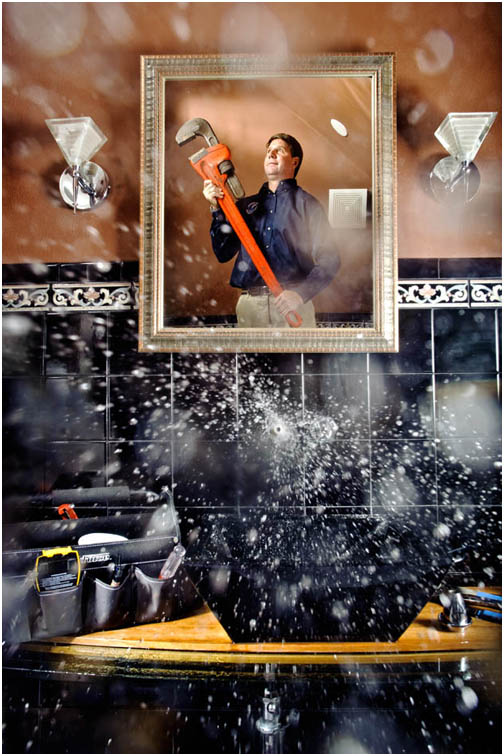
TID:
That gives us a great context to the Vet of the Year shoot, thanks.
Now let's talk about that image specifically.
MATT:
The Vet of the Year shoot was somewhat similar to the golf course shoot.
We scouted the location, met the human players and procured a "cone of
shame." We also had a story thought out. Admittedly, it was a bit less witty
than the golf photo. We wanted visual storytelling layers: a sad, sick, cute
dog, the caring vet, a connection between the two, and a concerned owner
peeking through the window.
A quick digression to set up my next point: the one thing I've learned over
the years is to shoot and EDIT for the READERS. I think journalists, editors
and managers can sometimes lose sight of who their real audience is. When
I was tired of getting yelled at by my bosses, the quality of my content became
weak. I knew the bosses wanted photos that told the complete story, regardless
of how underwhelming the image. I always wanna win the page flip war. If I
make an image -- scratch that -- if I can get an image PUBLISHED that makes
the reader intrigued, then I win! And, y'know, so does the reader.
If a reader sees a photo and reacts audibly then you have a great photo.
Unless it's groan from boredom.
"Hahahahaha!"
"Awwwwwwww."
"Wow!"
"What the…?"
"Gasp!"
"Sigh."
For all these Best Of photos I wanted to elicit an emotion by telling a story,
typically a funny story. With the vet shoot I was initially trying to make a funny,
yet cute picture that would make the viewers go, "Awwwww."
But by the grace of Dr. Barbara Feinstein, I ended up with this amazingly
absurd picture. I would've never story-boarded this image. And let's be honest,
if I pitched this idea, it'd most likely get thrown out. This wonderful instant
is the sum of a few hours of patient humans dealing with two remarkably
shy and uncooperative dogs. The first half of the shoot starred an entirely
different cast. And we made some pretty good photos, which I've included.
I think the one we almost used was the thermometer photo.
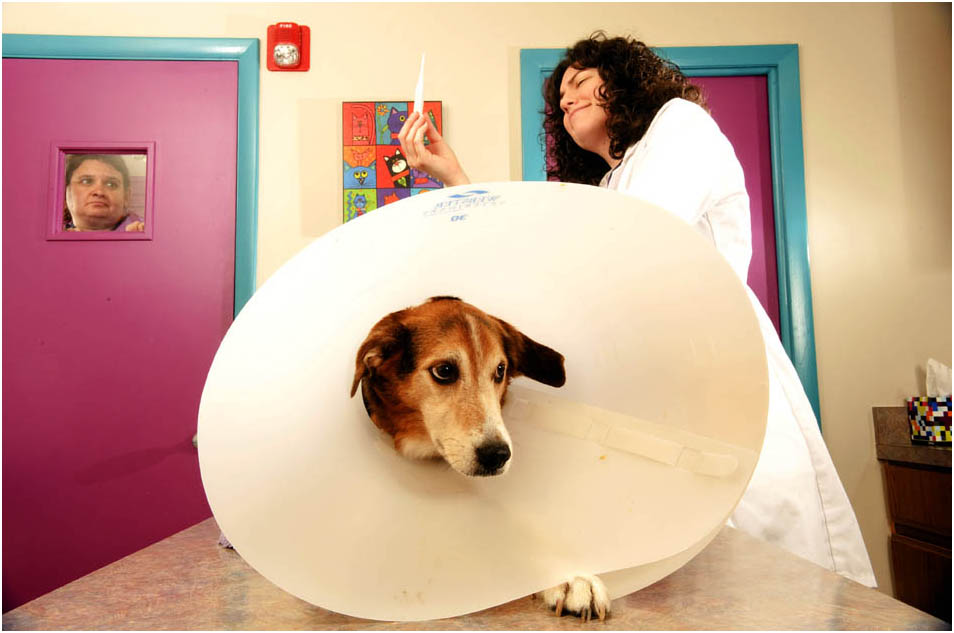
But when Dr. Feinstein came in, she suggested a little role reversal.
I was like, "Sure! You can put the cone of shame on your head. Are there
scrubs that'll fit Moosh? Oh! And a stethoscope! Can Moosh wear your
stethoscope, too?" But as you can see from the contact sheet, Moosh
cooperated for half a second -- which is good because all I needed was
1/160th of a second (waka-waka!)
What makes this photo work? It's their connection! I believe Moosh is
genuinely concerned for Dr. Feinstein in this picture.
TID:
This looks like it took a lot of time to organize. Did you call her in advance
to prep her, or the vet in any way?

MATT:
Oh yeah. Totally. Ha! You can't just barge into a vet's office, lights in tow,
flatter them with an award and expect them to give you like two hours of
their time. We were pencilled in. Heck, we were pencilled in for the location
scout. That alone took almost an hour. Don't get me wrong, looking around
the vet's office doesn't take that long. But when scouting locations, you
have to think about things like: Is this a good/clean/appropriate background?
Does this setting say "vet's office?" Will we be in the way of normal business
practices if we take over this space? Where will we put the lights if we use
this space? Will the lights create an unavoidable glare in that reflective
surface? And I had to be cautious of how close I was to the cats -- 'cause
I'm allergic! Don't worry, I took my pills. And debatably more important than
finding a good location, we have to establish rapport with our subjects or,
as I sometimes like to call them, "the protagonists!" Typically, but not always,
we try to use the business owners for these shots. Luckily, both owners
were game and very fun to work with.
TID:
You make this sound a lot easier than it probably was, mentally, to pull off
(which is a compliment to your style.) Could you please talk about how
you interact with subjects in preparation for a shoot, and also on
location?
MATT:
Ha! Thanks. I suppose in some sense, everything's easier in hindsight. But
if you'll let me diverge into another abstract truism, I'll answer this question
with a bit more idea-driven girth. Not to put too fine a point on it, you have
to know how you affect situations.
Like most photographers who cut their teeth in a photojournalism program,
we're told we need to be "flies on the wall." The thing I learned about myself
is that I can't operate like that. Well, I can, but I end up being that creepy,
bearded guy in the corner… with cameras. Yeah, who wants to talk to that
guy? I do think the "fly" approach works really well for the people who have
a quiet, ghost-like energy. But the thing is, it doesn't work for everyone.
You have to play to your strengths. Me? I tend to bring a loud, gregarious
energy into the room. That doesn't mean I make big, flamboyant entrances
(Ta-daaaa! Who wants some Matt Roth Photo action?) But it does help to be
self aware. More often than not, I realize that people notice me when I walk
into a room and yes, I realize how conceited that sounds. Trust me. It's not
for my looks (flips hair, purses lips, trips over an ottoman...) The point is,
I'm less successful when I attempt to be inconspicuous.
So, I try to ethically become part of the scene. I meld into it without messing
with it. Does that make sense? And when you set the rules of engagement
with a subject it helps to have a few boilerplate phrases. In fact, I learned a
really good phrase from my friend Patrick Smith. Rather than asking the
subjects to "ignore me," I ask them to "act like I don't have a camera." It might
sound like I'm splitting hairs, but I find asking people to ignore me (and my big
dumb energy) their mannerisms and eye contact look like they're avoiding
something (me!) in the pictures.

A lot of people, viewers included, understand that game, and know what
it looks like. But when I ask them to act like I don't have a camera, I also
encourage them to talk to me and ask me questions, if they want to. It's
great! Not only is the shoot more comfortable for both me and the subjects,
but it gives them license to relax. I'm not asking them to avoid the wooly
mammoth in the room. And of course, when people talk, you get to flex
your journalism muscles too. So if any of you fledgling photojournalists
out there are also failing or feeling weird using the "fly" approach,
switch your gears up. Get close. Be Chummy.
So to answer your question, my loud energy makes a ton of sense in a
photo shoot scenario. I actually feel like I'm on top of my game when
I have or am part of a crew. I guess when I have a crew to lead, I become
more confident and happy, which ultimately, puts the subject at ease.
Of course, it also helps to have extra hands on set too. That way I don't
have to move light stands and sweat the small stuff. I can just focus on
the subject.
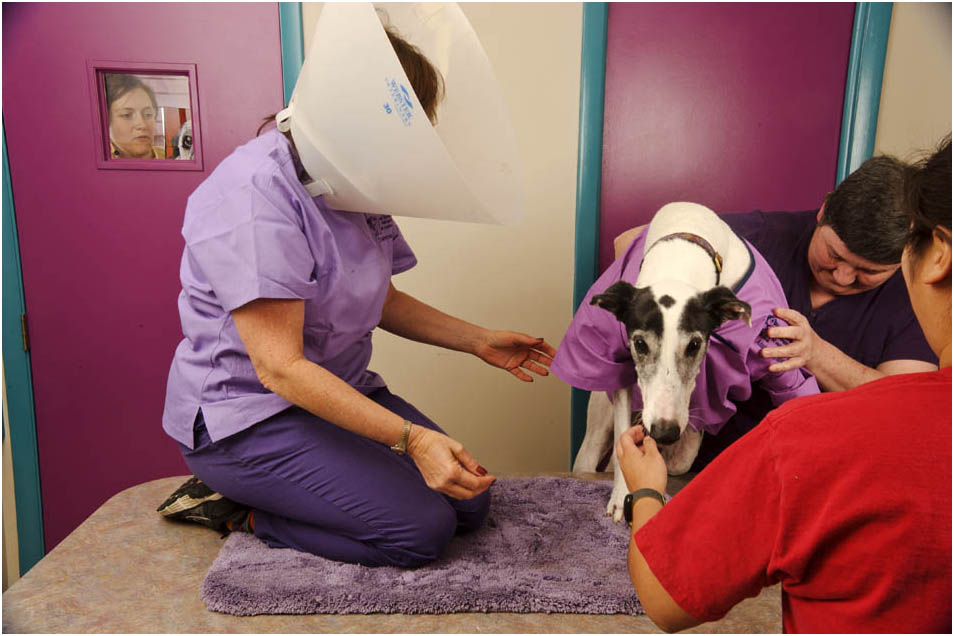
I genuinely like people too. So I try to have "the protagonists'" best
interest at heart. And here's the kicker... I also make sure they know that.
For my Athletes of the Year photos, for example, I told them
I want them to look like they're the stars of a Nike ad!
Think about it. Most of them reached their athletic apex being named
All-County. It's a big deal for them, and I think that's an important issue to
address. But the Baltimore Sun and the Washington Post (to a lesser degree)
so often employ the studio cattle call approach. Don't get me wrong, I
understand that method from the newspapers' perspectives, it saves time,
it makes the process easier. It's "streamlined," which means rigid and often
results in boring photo play. I'm not knocking the photographers.
I'm knocking the system. Almost every shooter on both of those staffs is ultra-
capable of banging out awesome portraits if they were given the time and
freedom. We were lucky at Patuxent. But for obvious reasons, the athletes
I've shot really don't like the cattle calls. So I use this opportunity to try to
make them feel awesome! And they'll gladly give me two hours
just to make sure they don't look weird kicking a soccer ball.
Form is important. …and remember, photos are forever.
And yes! I let them see the back of the camera, too. Only for portraits,
though. The exception being unless the issue I'm illustrating calls for an
unflattering picture of the subject, or if I've been given explicit instructions
to not show the subject the shoot. This does two things, it lets them know
that I'm genuinely interested in making sure they look good. And it lets
them know where they need to make adjustments. People are picky about
very specific things. Personally, I like knowing they LOVE the photos. I try
to be as transparent in my motivations as I need to be. If they understand
where I'm coming from and what I need from them, they're more likely to
play ball. Of course, there are exceptions. The end goal is to come to a
meeting of the minds. And like I said earlier, I've found a lot of success
from letting my subjects….er, Protagonists! add to the shoot.
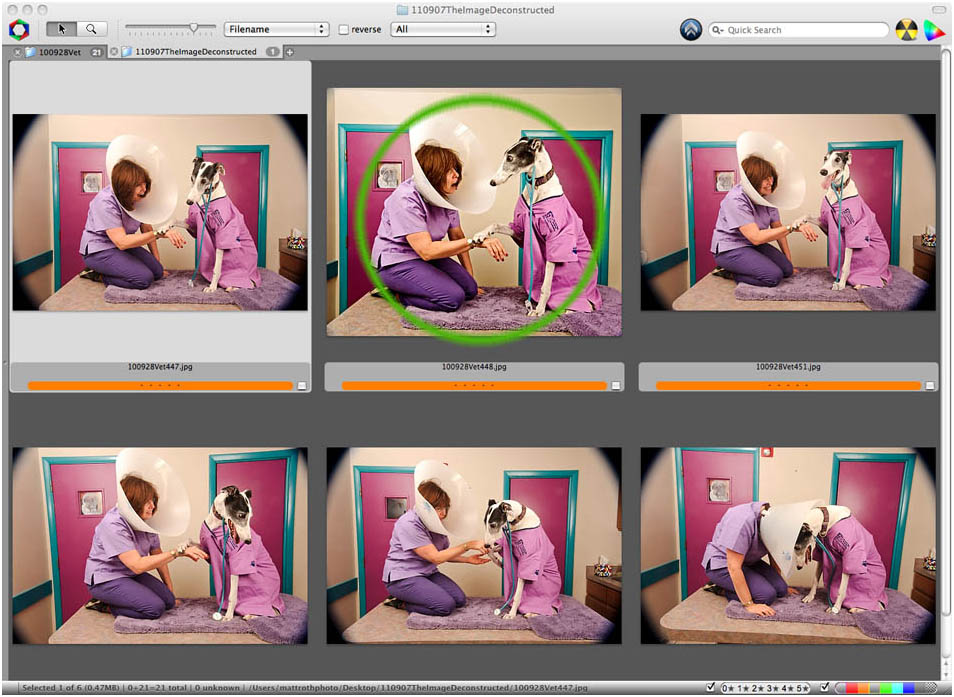
TID:
Can you briefly discuss how you approach lighting
for this and other assigments?
MATT:
Haha! Uh, a lot of people have me pegged as a lighting wizard… which
I'm not. I think I'm successful with lights only because I don't think they're
scary. I think using lights is fun. Each shoot is an experiment.
Sure, I have a few clutch set ups I rely on when I need to. I think
that whimsical attitude keeps lighting fun for me. But for this set up,
I think I shot through an umbrella behind me to my right and I bounced a
light off the ceiling to my left. I also set up a small speedlight zoomed to
105mm in one of the cabinets behind the subjects for some rim light --
but I'm pretty sure the batteries died way before this shot happened.
This photo doesn't rely on the lighting set up, and this was by design.
Sometimes lighting can be the reason to look at a photo, and our goal was
to tell a story. Lighting was only there to optimize the image's quality and
to ensure we could shoot at ISO 100.
TID:
What problems did you face during the making of this
image, and how did you overcome it?
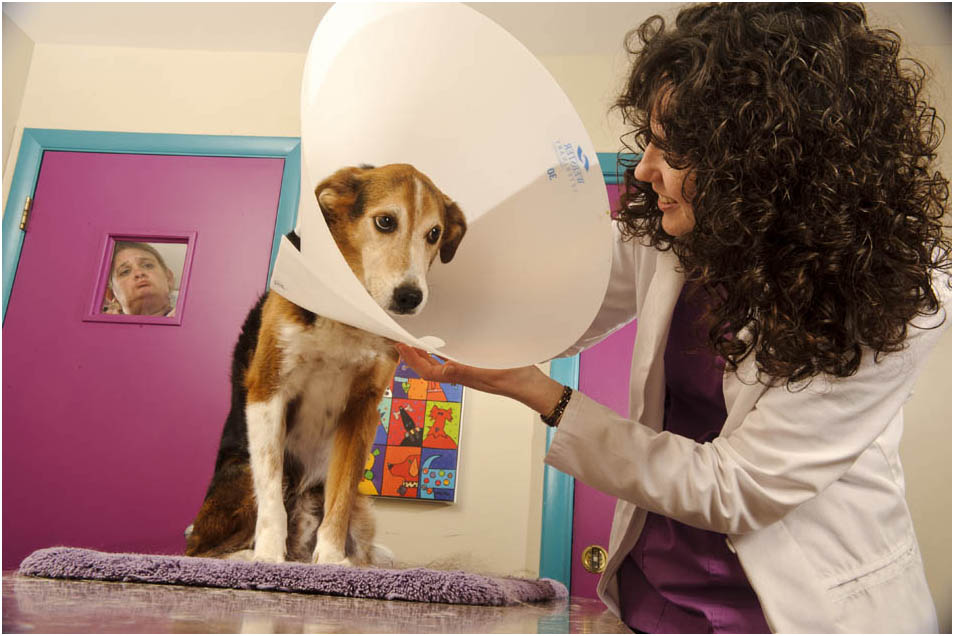
MATT:
Well, the obvious problems we faced were the dogs, which we anticipated.
They lost interest in what we were doing fast. The flash bursts scared them…
Well, that and they were in a vet's office. We all know how dogs get in a vet's
office, right? I'm sure if we had a budget, we would've hired a trained dog.
Truthfully, I'd say most of the shoot went wrong. But that was fine. We really
just needed three usable photos.
I guess I usually go into shoots expecting things to go wrong, so when
they do, I just deal with them -- and learn from them. Success is a process,
y'know? I knew the best photos would involve some kind of connection. And
eye connection is pretty powerful. Of course, timid dogs don't make eye
contact, so I tried looking for different stories to unfold. We almost went
with a photo of the first vet checking the first dog's temperature. It's funny
because those thermometers go up the dog's butt. And butts are funny.
But more than that, there was a pretty good little story being told too,
with concerned owner peering in from the outside window. We could've
easily wrapped after that shot, but it didn't quite have that, "Oh, hell yeah!"
effect I really wanted. So, I powered through. I knew there was better. And
a lot of you shooters out there can attest to that electric feeling you get when
you make that one "best image." Well, I got that feeling when I made the image
we're deconstructing.
The whole shoot was like climbing out of a valley.
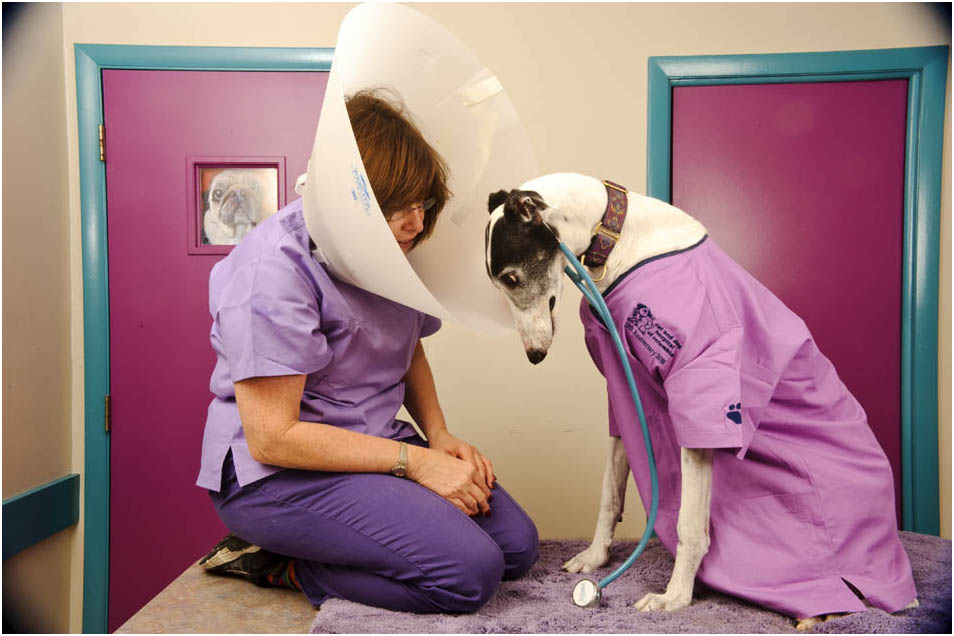
TID:
What have you learned about yourself that you didn't know
by making these kinds of images?
MATT:
Well, let's see. We all know It's easy for photographers to get pigeonholed.
And it's easy for us to let ourselves stay in those pigeonholes. Because of
my Athletes of the Year photos, I've become known as a sports guy -- which
I'm really not. Don't get me wrong, I like athletes, but I'm kinda dense when
it comes to the world of sports. But after the modest success I received from
these Best of Howard shoots, I really wanted dig my own pigeonhole as a
concept photographer. Those shoots were so, so much fun to create. I got
to use my imagination! How fun is that? It also made me realize that while
I'm a fine, competent photojournalist, I'm way better at being a portrait/
concept/editorial/commercial/advertising/making-stuff-up photographer.
I've also learned a ton more about how to use lights more effectively and
blah blah blah... But more recently I've learned that I need to learn how
to put the lights away, too. Lights are great! But lights are also horrible.
TID:
What have you learned about other people?
MATT:
The lesson to be learned from this shoot is to always be open. Open to your
subject's ideas (sometimes they're really horrible though) and open to a
change in idea. It was an important reminder to me that plans are only
as good as they are successful.

TID:
Thanks, Matt. Any final thoughts or advice?
MATT:
I've had my fair share of photographers ask me to help them learn how to
use lights. A lot of them think it's something they really need to master. I
tell them, don't make lights so big and serious. Remember the first time
you picked up a camera? How magical was that? If you think about lights
as something you need to get better at, you'll miss all the fun.
++++
Matt Roth is still in his first year as an independent photographer in Baltimore, Maryland. Up until December 2010, he was a staff photojournalist with the Patuxent Publishing Company for 6 years. While there, he was NPPA's Best of Photojournalism's 2007 Runner Up Photographer of the Year for Small Markets (what a mouthful, right?) He won a bunch of other awards, but whatever... His current clients include AARP Bulletin, Education Week, The New York Times, The Sporting News, The Chronicle of Higher Education, and ESPN the Magazine. He's working on (and failing at) a project where he makes one portrait a day until he turns 34 next August. And even though the project has already suffered lapses, he'd rather earn a B+ than a W/F (withdraw/fail). He also hopes that analogy makes sense. So, if you'd like to be portraitized (traumatized through a portrait shoot) feel free to contact him. Matt Roth is also working on a Matt Roth Project where he makes portraits of as many Matt Roths as he can find. Like the NFL player, the three-point specialist who sits the bench for the Hoosiers, the guy who used to be married to and starred with Laurie Metcalf on the TV Show "Roseanne," as well as the guitar player from Austin (which is in the works!) and the brother of Susan -- who he briefly dated in high school. Seriously. He dated a girl whose brother had the same name as him. He already photographed the OTHER Matt Roth photographer... And of course, if you know any Matt Roths feel free to contact him. Matt Roth also thinks is weird to talk about himself in the third person.
www.mattrothphoto.com/
http://mattrothphoto.com/blog
e: [email protected]
twitter: @mattrothphoto